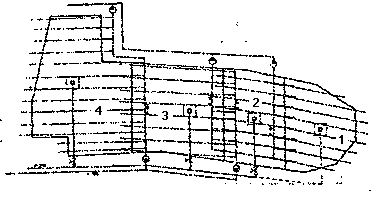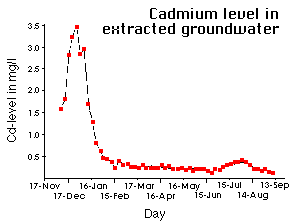
TEMA 19. Descontaminación de suelos contaminados
4 Casos prácticos
Practice case 5:
Flushing with acidified water Soestduinen
General
This is a practice case of the in-situ remediation of heavy metals. In spite of the fact that this technique has not been widely followed in other remediation cases, the applied techniques are interesting enough to be included in this overview.
Determination of the contamination situation
A photographic industry in the province of Utrecht discharged wastewater containing cadmium (Cd) into two infiltration ponds (balsas) during the years 1935 -1955. As these ponds overflowed from time to time, the adjoining dune area was contaminated. An enamelling (esmaltadora) and a galvanization company, situated next to the photographic industry, also produced wastewater containing Cd.
A soil investigation was required, as there was the risk of recreating humans having direct contact with the contaminated top soil layer in the woody area. Another risk was that the contaminants would spread via the groundwater towards a drinking-water pumping station.
A surface area of about 6,000 m2 proved to be contaminated, to an average depth to 4 to 5 metres. Figure 5.9 shows a cross section of the soil stratification and the contamination situation. The total cadmium load was estimated at 725 kg. The soil consists of moderately fine to moderately coarse sand (90% of the particle size fraction is 63 - 500µm). Because the organic carbon and lute (arcilla) fractions of the soil are rather small, so too is the adsorption capacity of the soil (Urlings 1990 and Vijgen l992).

Figura 5.9. Cross section of the soil stratification and the contamination situation.
Weighing of the remediation alternatives
The possibilities of cleaning up the contamination by in situ remediation and excavation were weighed during the remediation investigation. The in situ remediation concept was based on flushing the soil with acidified water.
In situ remediation was expected to be much cheaper than conventional excavation. An additional investigation was required to determine the feasibility and dimensioning of the in situ remediation.
Feasibility investigation
The following aspects were further investigated during the additional investigation:
![]() Cd desorption from the contaminated soil
Cd desorption from the contaminated soil
![]() hydrological system of water infiltration and
extraction
hydrological system of water infiltration and
extraction
![]() treatment of Cd-containing water
treatment of Cd-containing water
Cd desorption from the contaminated soil
A desorption liquid was selected by shake experiments with contaminated soil. Column tests were then performed to determine the leaching characteristics while using the selected desorption liquid. Water acidified (pH=3) with hydrochloric acid (HCl) proved to be one of the best and most easily applicable desorption liquids.
The hydrological system of infiltration and extraction of water
The surface area to be remediated was 6,000 m2. For practical reasons, the capacity of the water treatment installation was restricted to a maximum of 250 m3/hour. Based on the hydrological properties of the soil, the site was partitioned into four compartments that were treated one after another.
A two-dimensional computer model was used to dimension the infiltration and extraction system. In order to avoid part of the infiltrated water seeping to the groundwater, a small volume of groundwater was extracted from the aquifer and discharged into the sewage system after treatment, with a preferred discharge flow rate of ca. 10% of the total extraction rate.
The acidified water was infiltrated via a pond. After percolation through the soil. the flushing water was pumped up via a drainage system and recirculated after treatment to the pond. The drains were installed using deep drainage. Figure 5.10 gives an overview of the remediated location.

Figure 5.10. Overview of the remediation system on the location
Treatment of Cd-containing water
Suitable water treatment options are: precipitation, biosorption and ion exchange. As in this case the treated percolate water is recirculated and the flow rate was rather high (250 m3/h), sorption on resins was the best of these options.
A resin with a high specific Cd-adsorption capacity was selected on the basis of laboratory shaking tests. This resin also performed well in the presence of high iron, aluminium and calcium concentrations, and at a pH of 3.5. The IMAC GT-73 resin proved to be the most suited.
The extend to which the resin could be regenerated was investigated by means of column tests. Practically complete regeneration proved to be possible with a 5% solution of HCI.
Detailed design
After performing these experiments, an in situ remediation system was designed. As there were still some doubts about the functioning of the system in the field, a test compartment was remediated before the full-scale in situ remediation started.
Execution
Test compartment
The in situ remediation of the least contaminated compartment (1) started in Augustus 1987. The results of this test were used to fine-tune the remediation of the remaining contaminated soil.
The results proved that:
![]() desorption of cadmium in practice corresponded
to the 1aboratory test results
desorption of cadmium in practice corresponded
to the 1aboratory test results
![]() the permeability of the soil was lower than
initially measured (presence of a thin soil layer with a high resistance)
the permeability of the soil was lower than
initially measured (presence of a thin soil layer with a high resistance)
![]() the water treatment functioned well
the water treatment functioned well
According to these results, the sizes of the other compartments were adapted, and extra infiltration drains were installed at 2.25 m-gl, with a view to the lower permeability. The mutual distance between the extraction drains (at 5.5 m-gl) was reduced from 4.5 m to 3 m.
Full-scale remediation
In December 1977, remediation of the other compartments (2, 3 and 4) was begun.
Cd concentrations in the pumped-up percolate and in the soil were determined after the remediation had been concluded. The natural pH of the soil was then restored by the infiltration al water with lye.
Figure 5 11 shows the Cd concentrations in the percoIate ot compartment 3. After high initial concentrations of 3,500 µg/l, they had decreased to 10-20 µg/l by October 1988.

Figure 5.11 Cadmium concentrations in percolate of compartment 3
Completion
In autumn l988, the remediation objective of 2.5 mg/kg was widely achieved. Most of the analyzed soil samples (90%) contained concentrations below l mg/kg. Only in a small area in companment 4 were cadmium concentrations too high, but this could be attributed to specific local conditions. This area was therefore excavated (about l00 m3). All in all, about 440 kg cadmium was removed from the location.
Total costs including costs of preliminary investigations amounted to ca. USD 2.0 million.
The province of Utrecht commissioned the project, and retained the contractor Mourik Groot Ammers for the installation and maintenance of the system, and the environmental consultancy Tauw Milieu bv for the preliminary investigations, the design, and supervision of the remediation.
After completion
The concept of extractive in situ remediation described above has not until now (l996) been widely followed up. In a way, the conditions of this project were unique, with only one metal contaminant and a subsoil consisting of moderately fine to moderately coarse sand.
The following comments can be made regarding the adaptability of the remediation concept used here to other contaminated locations:
![]() the results of laboratory tests to determine
the sorption behaviour of the contaminants reflected the practice conditions
very closely
the results of laboratory tests to determine
the sorption behaviour of the contaminants reflected the practice conditions
very closely
![]() this full-scale remediation has proved that
the in situ remediation of soil contaminated with heavy metals to an acceptable
level of 1 mg/kg is achievable
this full-scale remediation has proved that
the in situ remediation of soil contaminated with heavy metals to an acceptable
level of 1 mg/kg is achievable
![]() a watertight infiltration and extraction system
can function without losing infiltration water so the soil
a watertight infiltration and extraction system
can function without losing infiltration water so the soil
![]() the chosen infiltration method was feasible.
the chosen infiltration method was feasible.